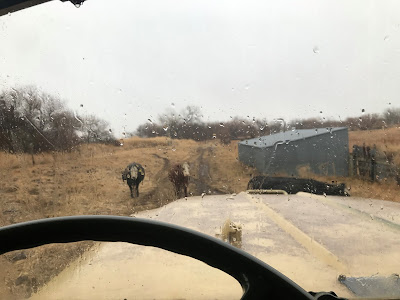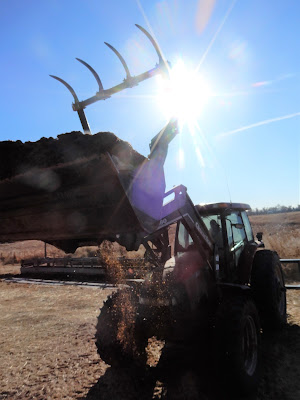Neither snow nor rain nor heat nor gloom of night will keep us from our appointed rounds.
It's not just a slogan for mail carriers. Cattle feeders can relate.
Through snow ...
Rain ...
Hail? It's usually not a factor during a Kansas winter.
Heat? Also usually not an issue. More often, the rather drafty feed truck cab is plenty chilly.
Dark? While I know some people feed closer to dark, we feed in the mornings. So no gloom of night required - unless we have cattle out. And that has been known to happen on occasion.
Feeding cattle is an everyday occurrence during the winter months for Kansas farmers/ranchers. The pastures that provided plenty of feed for the summertime are dried and brown. So we deliver takeout to the feeder calves and to the cows who are in the County Line maternity ward.
So what does this every-day routine entail?
First stop for me is the shed to get my trusty chariot. (First stop for Randy is feeding and watering the other livestock - the farm cats.) He usually starts up the loader tractor to warm up, too.
After revving up the feed truck, I get a short concert, if you can call a monotone blaring alarm a concert.
Until the air brakes build up pressure, the alarm sounds, and I wait to back the truck out of the shed.
I only shared 5 seconds of it: You're welcome!
Next, I pull under the grain bin and Randy deposits grain in the bottom of the truck. He uses the highly-scientific method of yelling, "Up!" when he wants me to move the truck forward to evenly distribute the grain, and then "Hold it!" when he wants me to pause.
As a courtesy to the "feed truck traffic controller," I keep the heater blower disengaged so I can hear him. Honestly, the heater doesn't work that efficiently anyway, since I have built-in air circulation through both the driver's side and passenger windows.Then we go 1/4 mile north to the pasture where the trench silo is located, crossing this wooden bridge.
Because the turn radius is tight and to make sure I don't end up in Peace Creek, I pull into a driveway past the actual entrance into the pasture, back up and then come in from the north, where I wait on Randy to open the gate.
Every morning, Randy uses the loader tractor to scoop out silage from the trench silo. We feed the silage that was harvested in the early fall. (Click here to read more about filling the trench silo.)
Several scoops later, we're ready to be Meals on Wheels and deliver the silage to the feeder calves.
Once I get a thumbs up, it's time to get the truck turned around and headed back to the corrals.
We do it whether it's a relatively nice - though chilly - day ...






































Satisfied customers and reader!
ReplyDeleteI don't think any Australian farmer would have to follow this winter regime.
Love following you along.
Thanks, Helen!
Delete